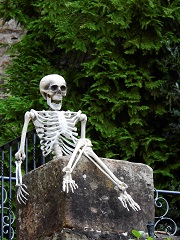20 October 2017
 Does body fat protect you against osteoporosis or make you more vulnerable to fractures? A new study by the University of South Australia hopes to shed light on this question.
Does body fat protect you against osteoporosis or make you more vulnerable to fractures? A new study by the University of South Australia hopes to shed light on this question.
Today is World Osteoporosis Day, highlighting a common disease that affects more than one million Australians who suffer from poor bone density and altered bone quality – a number expected to increase as our population ages.
UniSA PhD candidate Ms Deepti Sharma is recruiting 120 post-menopausal women – both lean and overweight – to investigate how a person’s body composition influences the effect of calcium to protect against bone loss.
“We know how much daily calcium someone needs to consume to help protect against osteoporotic fractures later in life. However, it is not known whether the recommended level or source of calcium should be adjusted depending on someone’s body composition,” says Sharma.
“People who are obese may have poor quality bones and may need to adjust their source of calcium to account for this.”
The trials form the second stage of Sharma’s PhD thesis which also looks at the role of vitamin D in protecting bone health. She has recruited more than 100 patients undergoing hip replacement due to fractured hips and analysed their bones for structure, gene expression and measured blood biochemical profile.
“What we have found is that high levels of vitamin D in the blood are associated with improved bone structure.
“We have known for some time that people who have higher vitamin D levels have reduced fractures. Now we are showing that vitamin D is linked with improved activity in the bone and better quality of bone. This is something which we have not previously been able to see using standard bone mineral density tests,” she says.
Sharma’s supervisor, Associate Professor Paul Anderson, says the findings could change clinical practice.
“Our findings not only suggest that vitamin D and calcium are essential to prevent fractures but also that both may help improve fracture healing,” Assoc Prof Anderson says. “We now know that even if you are in your 80s, if you have high levels of vitamin D you can improve the quality of your bones.”
Published data shows that up to 58 per cent of southern Australian women are vitamin D deficient during winter due to a lack of sun exposure. Even during summer, 42% of women are vitamin D deficient due to lifestyle factors such as avoidance of the sun and the use of sunscreen protection.
Prof Anderson says most people need to expose their face and arms to some direct sunlight when the sun is high in the sky so that the body can make vitamin D naturally.
“If that can’t be achieved, it may pay to visit your GP to get a blood test. If you are deficient in vitamin D, then taking a supplement is a safe and effective way to restore vitamin D levels.
“But when it comes to osteoporosis, it’s not just about getting enough vitamin D and calcium,” Assoc Prof Anderson says. “Low intensity, frequent, weight-bearing exercise is also crucial for optimal bone health.”
Media contact: Candy Gibson mobile 0434 605 142 email mailto:candy.gibson@unisa.edu.au
Additional notes
Osteoporosis is a common and silent disease with no obvious symptoms until a fracture occurs. There are approximately 400 fractures per day in Australia as a result of osteoporosis. Breaking a bone is very painful but there are longer term effects such as difficulty in walking and it has now been shown that fractures contribute to premature death.



